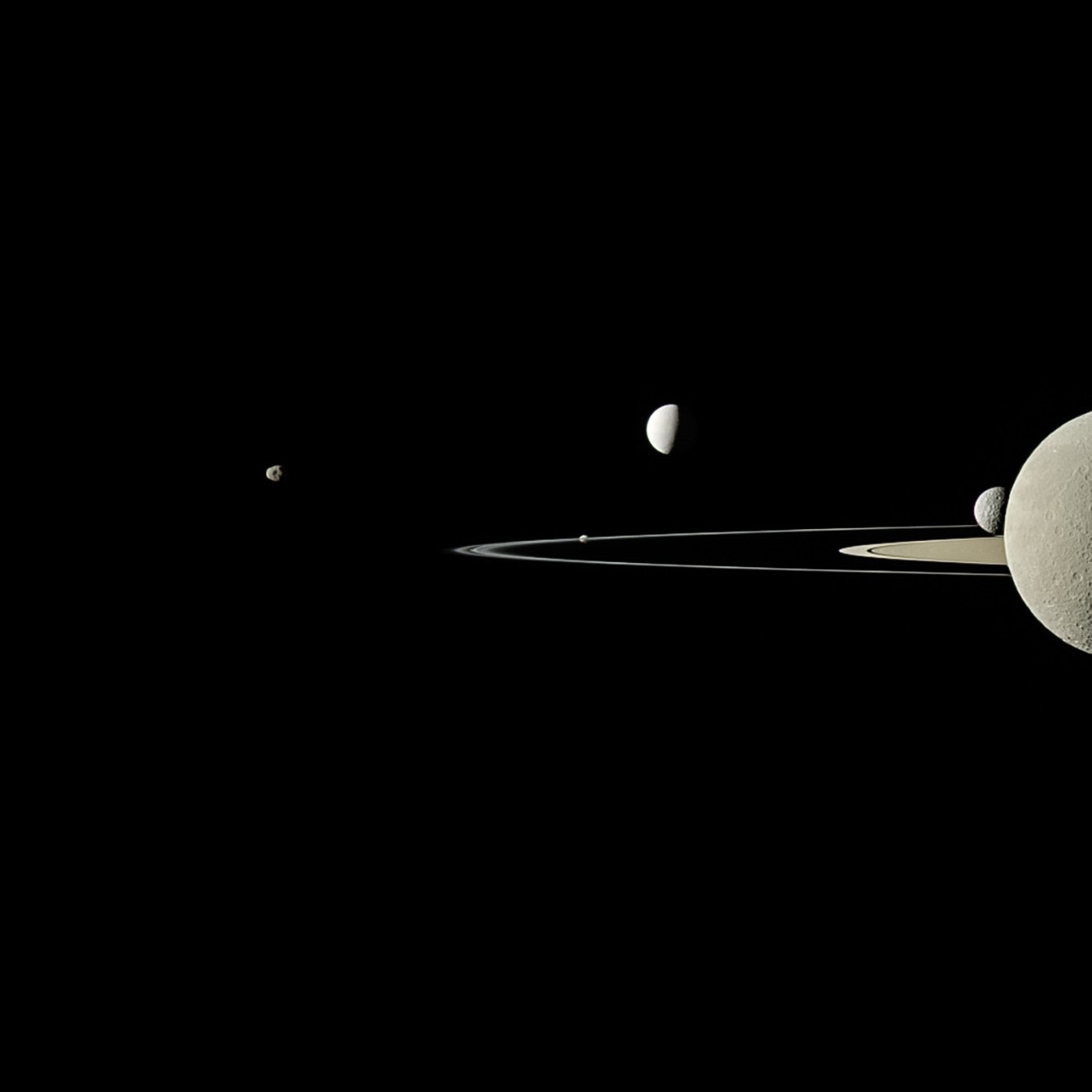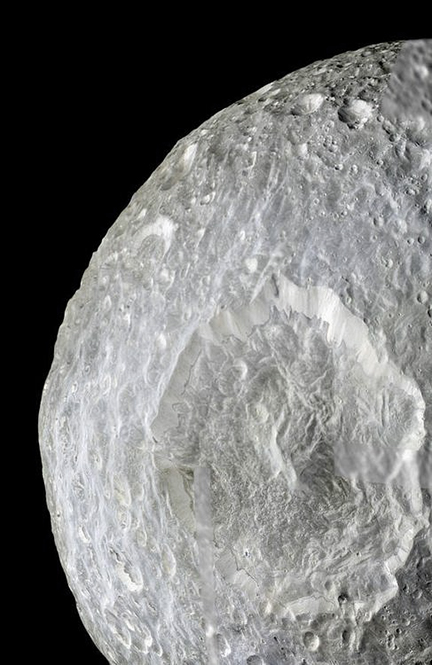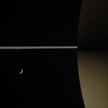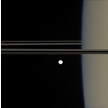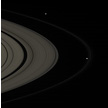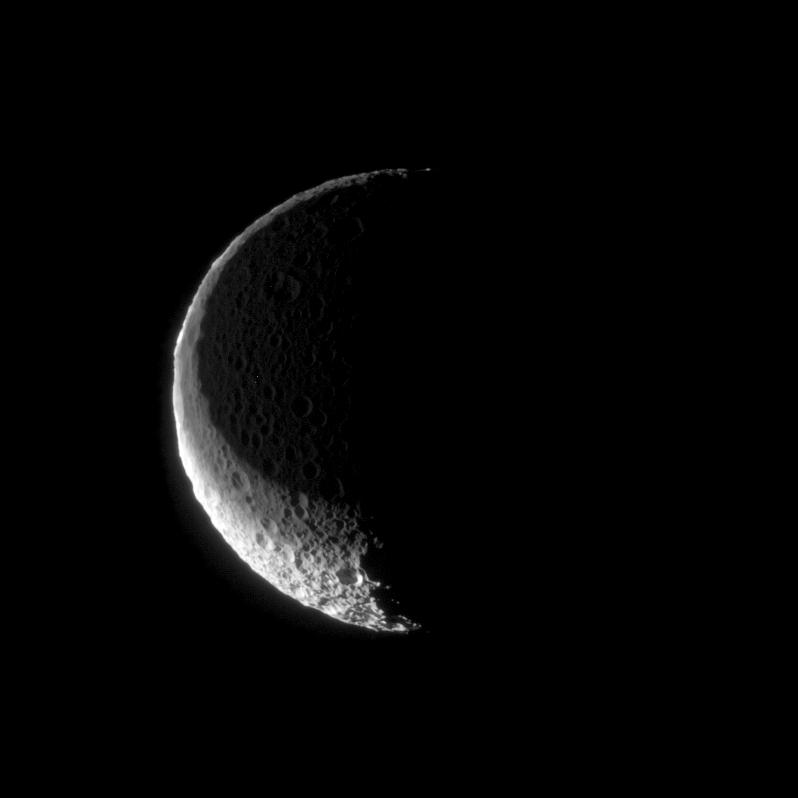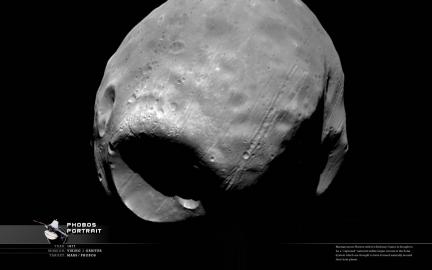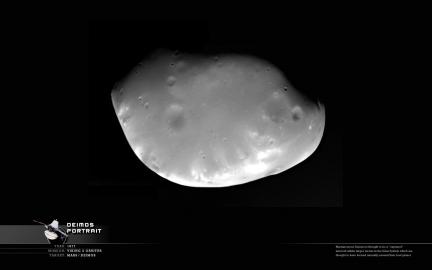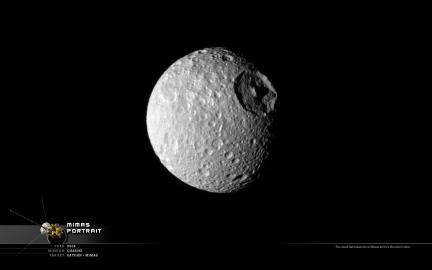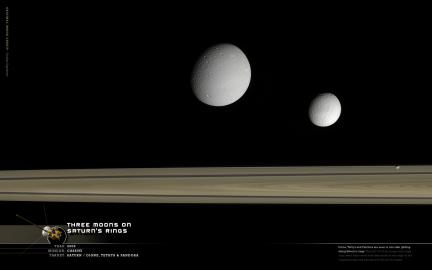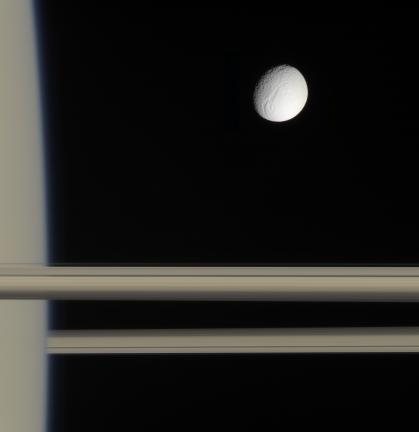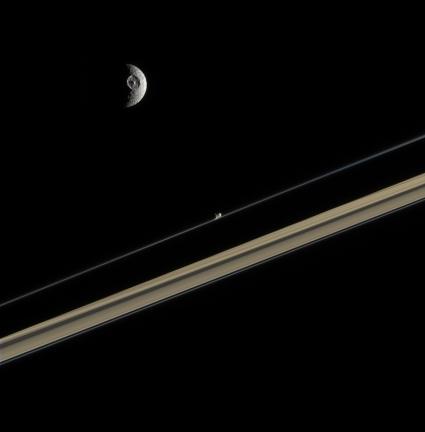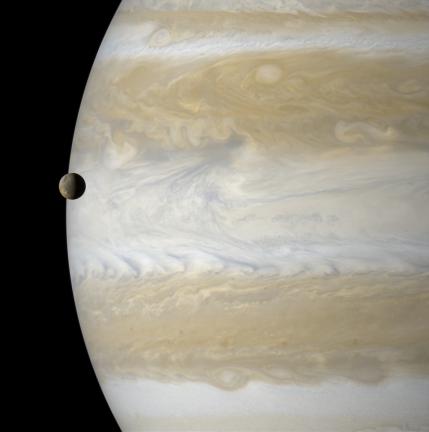From planetary.org: On July 29, 2011, Cassini captured five of Saturn’s moons in a single frame with its narrow-angle camera: Janus, Pandora, Enceladus, Rhea, and Mimas. NASA/JPL-Caltech/Space Science Institute. This is a full-color look at a view that was originally published in September 2011.
Cassini Image of Mimas & Tethys
Taken 2006. Posted by landru79.
Discover’s Best of Amateur Imagers
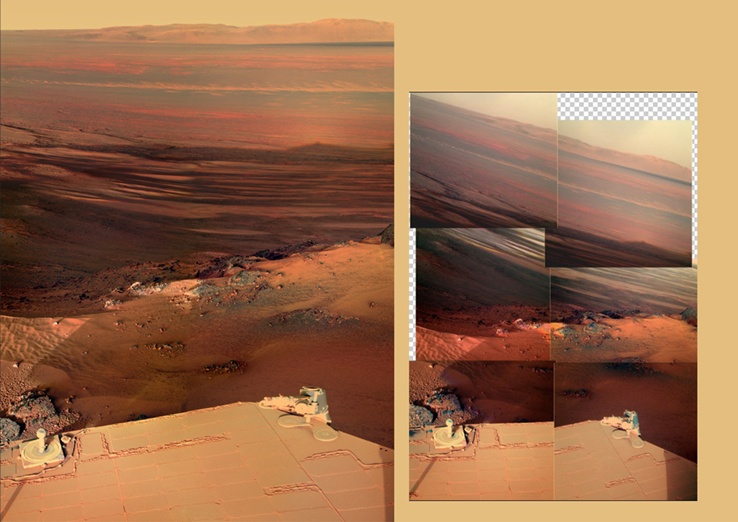 Discover online has an article today about some of the best in amateur space imaging. Many of which have been featured here on Wanderingspace before like Gordan Ugarkovic, Emily Lakdawalla and Bjorn Jonsson to name a few. The last item from Bill Dunford of Riding With Robots is an image that he actually suggested NASA point their HiRise cameras at that location. He suspected they might find something interesting there and they did —flash water movement and evidence of avalanches.
Discover online has an article today about some of the best in amateur space imaging. Many of which have been featured here on Wanderingspace before like Gordan Ugarkovic, Emily Lakdawalla and Bjorn Jonsson to name a few. The last item from Bill Dunford of Riding With Robots is an image that he actually suggested NASA point their HiRise cameras at that location. He suspected they might find something interesting there and they did —flash water movement and evidence of avalanches.
Around Saturn
Around Saturn from fabio di donato on Vimeo.
In Saturn’s Rings Official Trailer
The long awaited official trailer for “In Saturn’s Rings” has been unleashed. Looking forward to this film for over three years now.
Mimas and Herschel
Saturn’s Five
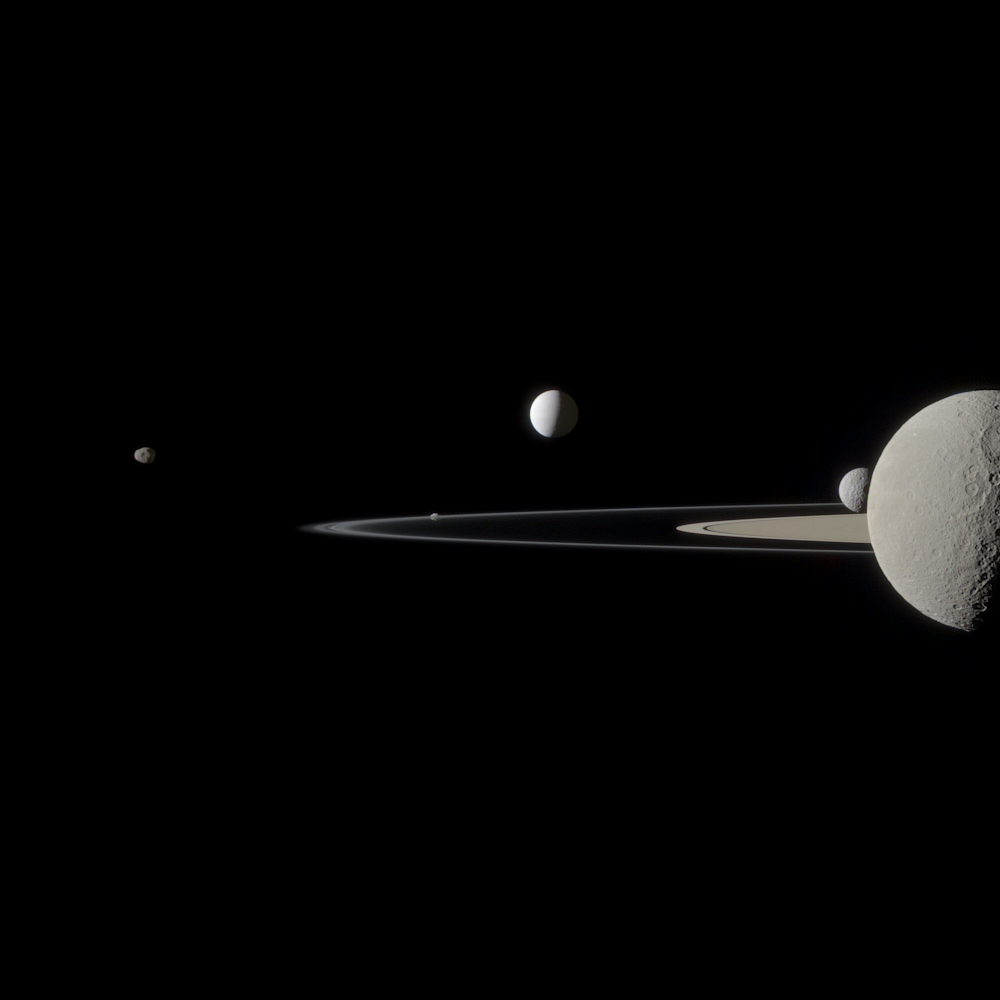 Space enthusiasts seem to really like shots that have more than one body in the same frame. How about five… or six (if you count the rings of Saturn)? Starting left to right that is Janus, Pandora, Enceladus, Mimas and Rhea.
Space enthusiasts seem to really like shots that have more than one body in the same frame. How about five… or six (if you count the rings of Saturn)? Starting left to right that is Janus, Pandora, Enceladus, Mimas and Rhea.
Thanks again to Gordan Ugarkovic.
Mimas Wanders Into the Frame
The Death Star Moon in Great Detail
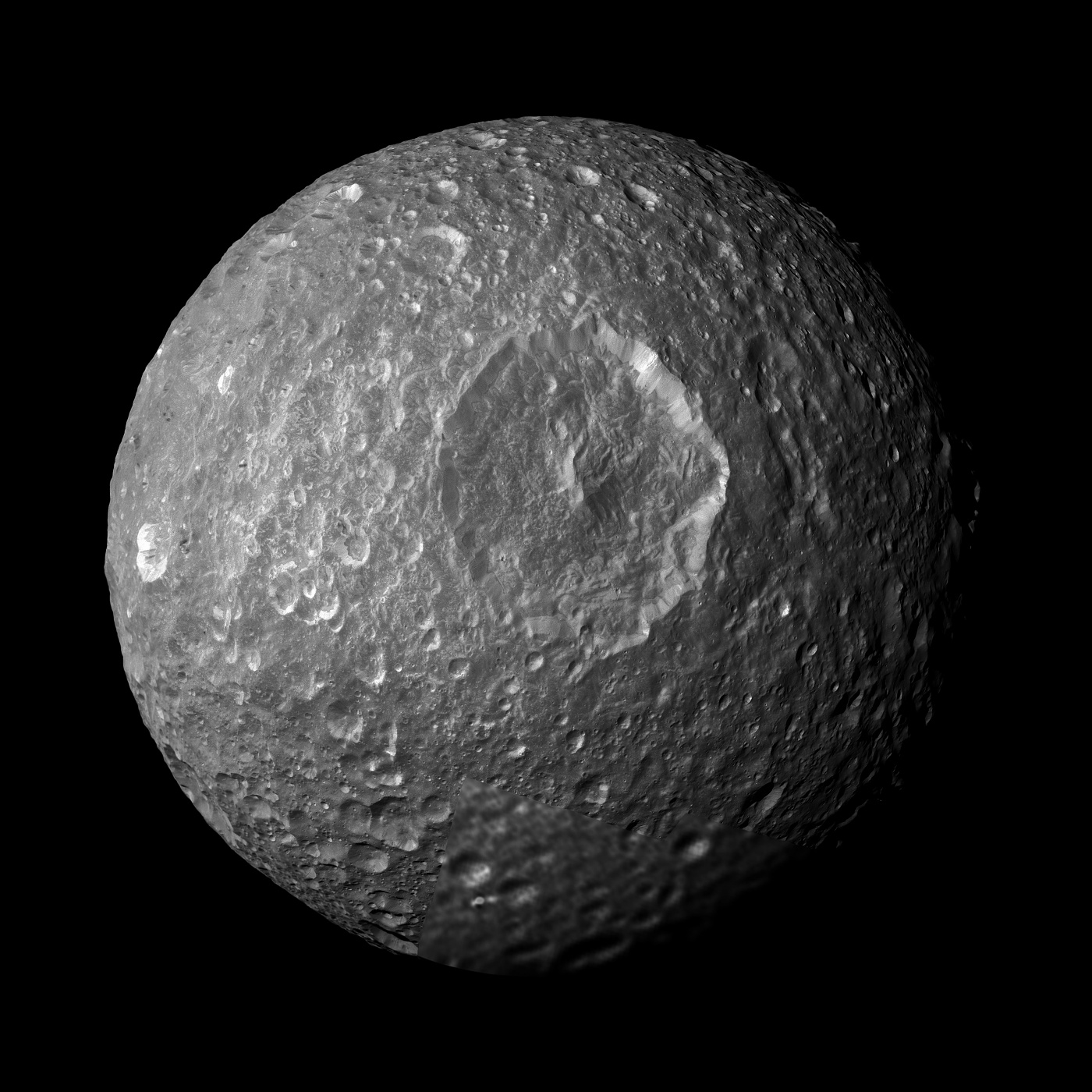 Commonly known by most as that “Death Star Moon” — Mimas, is seen here in the some of the finest detail ever (and seen here in sick detail). Flying to within 9,500 kilometers (5,900 miles) of the moon, Cassini captured the infamous Herschel Crater dead center in the still frame. Herschel, a feature which upon its originating impact, likely came close to shattering the tiny moon into another Saturnian ring.
Commonly known by most as that “Death Star Moon” — Mimas, is seen here in the some of the finest detail ever (and seen here in sick detail). Flying to within 9,500 kilometers (5,900 miles) of the moon, Cassini captured the infamous Herschel Crater dead center in the still frame. Herschel, a feature which upon its originating impact, likely came close to shattering the tiny moon into another Saturnian ring.
The image itself is a mosaic of several high-resolution images carefully placed together to make a full disc image. The lower right hand corner segment is (sadly) in a much lower resolution than the rest, but I’ll bet you didn’t even notice until I pointed it out and ruined it for you.
Saturn Through the Eyes of Hubble
Gordan, King of Rock N Ice
 The King of Saturn imagery does it again. One of the key images that inspired me to even start this blog was the NASA officially produced image of Mimas against ring shadows. This one is pretty much just as stunning. Gordan has knocked out a few other Saturn images recently, all worth a look at his flickr stream.
The King of Saturn imagery does it again. One of the key images that inspired me to even start this blog was the NASA officially produced image of Mimas against ring shadows. This one is pretty much just as stunning. Gordan has knocked out a few other Saturn images recently, all worth a look at his flickr stream.
Mimas in Ring Shadow
Cassini Team Shows Some Color
NASA released an unusually large amount of color images to the Cassini website recently. Most of what is shown here on this site are actually images put together by freelance imagers who access the raw files and do some stitching together of filtered images. Color images coming straight off the Cassini website are a rare event, so when about 8 appeared in the gallery a few days ago… it was an unexpected gift.
 Saturn as seen from the unlit side of the rings.
Saturn as seen from the unlit side of the rings.
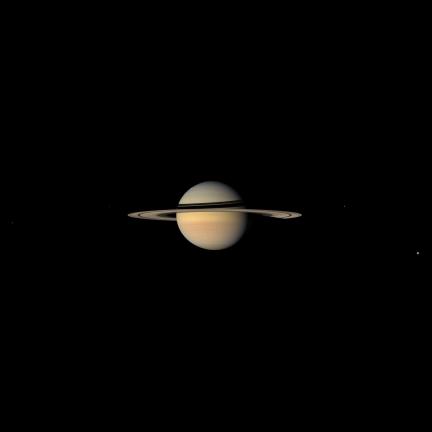 A family portrait of the Saturn System. Moons visible in this image (you need to click the preview) are Dione at far left, Enceladus near the left side ring edge, Mimas a speck on ring shadows on the western limb, Rhea against the northern hemisphere, Tethys near the right ring edge, and Titan near lower right.
A family portrait of the Saturn System. Moons visible in this image (you need to click the preview) are Dione at far left, Enceladus near the left side ring edge, Mimas a speck on ring shadows on the western limb, Rhea against the northern hemisphere, Tethys near the right ring edge, and Titan near lower right.
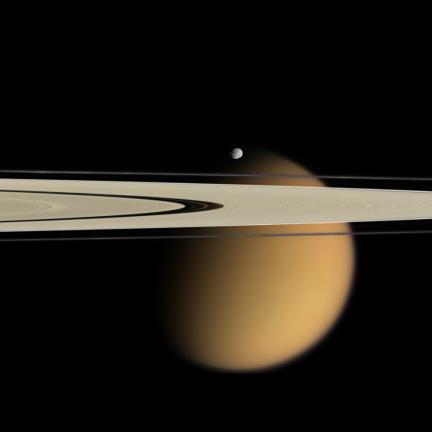 Titan and a small moonlet named Epimetheus share the frame with Saturn’s rings.
Titan and a small moonlet named Epimetheus share the frame with Saturn’s rings.
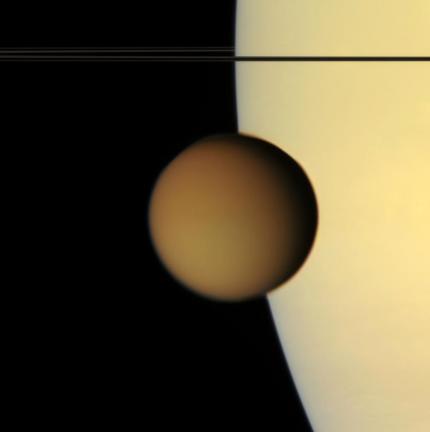 A rare color view of both Saturn and Titan in one frame. This is the only one of its kind thus far in the mission.
A rare color view of both Saturn and Titan in one frame. This is the only one of its kind thus far in the mission.
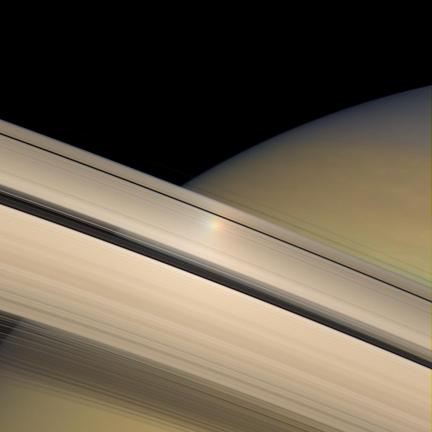 A small rainbow appears as sunlight streams through Saturn’s rings.
A small rainbow appears as sunlight streams through Saturn’s rings.
Enceladus, Mimas Transit Saturn
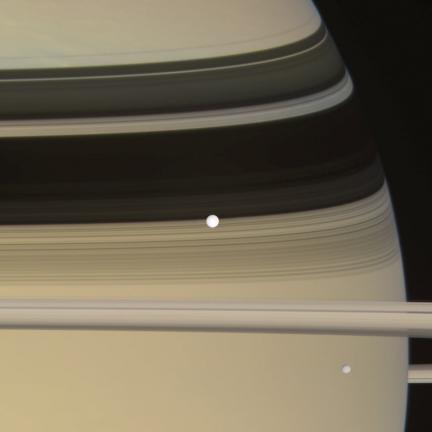 Here is a recent set of raw Saturn images (red, green and blue filters) combined to create a near-true color shot.
Here is a recent set of raw Saturn images (red, green and blue filters) combined to create a near-true color shot. 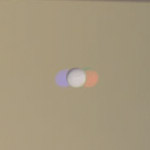 Of course, the moons and Cassini were both moving and changing the perspective of the 3 bodies from one another from one filtered exposure to the next (the effects of which can be seen at left). So it was required that the 2 moons be “lifted” from the main image, properly registered for each individual moon and then merged back into the main composition. Once in place, a bit of Photoshop retouching was needed to erase the echoes in the 2 other channels where the moons were before registration was corrected.
Of course, the moons and Cassini were both moving and changing the perspective of the 3 bodies from one another from one filtered exposure to the next (the effects of which can be seen at left). So it was required that the 2 moons be “lifted” from the main image, properly registered for each individual moon and then merged back into the main composition. Once in place, a bit of Photoshop retouching was needed to erase the echoes in the 2 other channels where the moons were before registration was corrected.
The raw files archive on the Cassini site only reports which object was targeted, so it did not specify that the other moon is Mimas… but I cannot image what other globe that could possibly be seemingly inside Enceladus’s orbit.
Wallpapers: Some of the Minor Moons
Image Processors on Flickr: Gordan Ugarkovic
Gordan Ugarkovic has a great collection of reworked Cassini images on Flickr. I contacted Gordan about showing some of his images here on wanderingspace and he was ever so gracious. As many people Gordan is “somewhat underwhelmed by the frequency the Cassini Imaging Team releases color composites”, so it is up to excellent freelancers like him to compile this information from the data files which are made public by NASA. Problem is that these images rarely make it to the mass media and we are stuck with the dozen or so color images the NASA imaging teams decide to produce in a year.
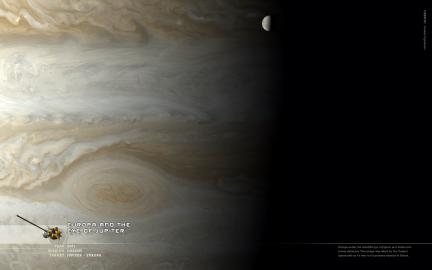
WALLPAPER NOTE: The left 1/3 of the “Three Moons” image was extended in Photoshop using data at the edges of the original image which was cropped to a square format. This “fake” imagery was only applied to that area of the rings and the rest of the image including the moons is actual.
Here are some other images from Gordan which are some of my favorites, but don’t trust my editing… go to the gallery and have a look yourself. For the sake of posterity I have added a permanent link to his gallery on the right side of this blog where you may note that there are already a few others linked. There were two additional ones but the sites have been taken down since I linked to them?! Hopefully the three left will stick around for a while and I will in time add more to the collection.
Tethys and Saturn’s Hazy Limb
Mimas and Prometheus on Rings
Io on Jupiters Edge
Wallpaper: Saturn and Mimas
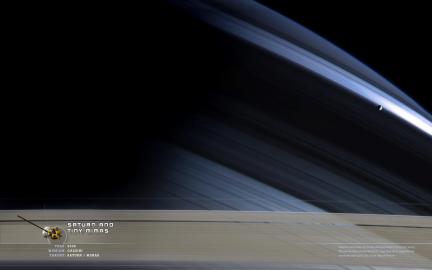 One of my favorite wallpaper images from the Cassini mission. This image almost looks like one of the fantastic Chesley Bonestell images from the 80’s only its not a painting. What you see are Saturn’s rings along the bottom and tiny Mimas floating across Saturnian cloudtops which are being shadowed by the rings. It is thought that these deep shadows, in addition to Saturn currently being in winter, somehow cause less clouds to form in Saturn’s northern hemisphere and create the blueish appearance seen here. When the Voyager’s passed by Saturn in the 80’s the entire globe appeared to be peach colored and lacked any of the blues you see today.
One of my favorite wallpaper images from the Cassini mission. This image almost looks like one of the fantastic Chesley Bonestell images from the 80’s only its not a painting. What you see are Saturn’s rings along the bottom and tiny Mimas floating across Saturnian cloudtops which are being shadowed by the rings. It is thought that these deep shadows, in addition to Saturn currently being in winter, somehow cause less clouds to form in Saturn’s northern hemisphere and create the blueish appearance seen here. When the Voyager’s passed by Saturn in the 80’s the entire globe appeared to be peach colored and lacked any of the blues you see today.
IMAGE NOTE: The left 1/5 of the image (the rings) is a digital extension of the image data found near the edge of the original image. This was done simply to fill out the proportion as the original was cropped to about 4/5 the the width.
That’s No Moon
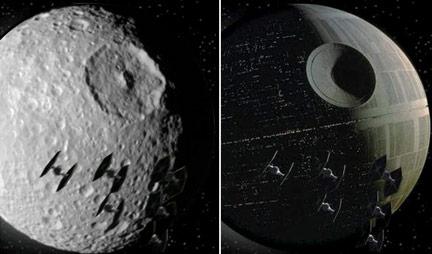 In 1977 George Lucas released Star Wars and in it was featured the now infamous Death Star space station which was justly destroyed in the films final scene. That same year Voyager 1 was launched from Earth on its way to the outer solar system. On its way through the Saturnian system it relayed back images of a moon that bore a striking resemblance to Lucas’s own vision of the Death Star.
In 1977 George Lucas released Star Wars and in it was featured the now infamous Death Star space station which was justly destroyed in the films final scene. That same year Voyager 1 was launched from Earth on its way to the outer solar system. On its way through the Saturnian system it relayed back images of a moon that bore a striking resemblance to Lucas’s own vision of the Death Star.
The only feature that really makes the resemblance complete is the presence of the Herschel crater which, like the Death Star, occupies almost 1/3 the moon’s own diameter. The central peak, which often occurs on larger sized impacts, also makes for a good stand in for the giant laser turret that destroys planets. With results of the Voyager mission streaming in a few years after the film became a smash hit and just a few months after the release of “Empire Strikes Back” one has to wonder if anyone at mission control uttered the words, “That’s no moon”.
However, while the circular feature on the Death Star destroys other worlds, Mimas’s giant circular feature nearly destroyed its own self. The crater is so large in comparison to the size of the moon itself it is believed that it was quite close to shattering the small moon into many bits which maybe could have resulted in even more rings for Saturn. As it is there are fractures on the opposite side of the moon which some suggest may be stress lines from that same impact and show evidence that the moon did start to become unhinged. Proportional to the size of the body itself, this is the largest crater in the Solar System with only Mars’s moon Phobos coming close with its Stickney crater.
Wallpaper: Mimas Against Ring Shadows
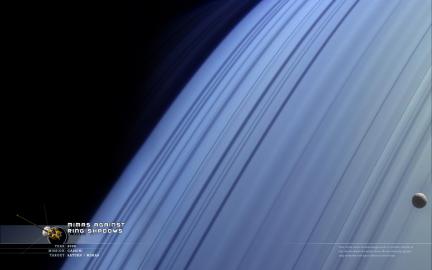 In one of Cassini’s more surreal images, the small moon Mimas is seen floating across the ring shadows cast upon Saturn’s cloud-tops. Mimas is a rocky 400km moon whose most notable feature is a 130km crater that dominates its appearance.
In one of Cassini’s more surreal images, the small moon Mimas is seen floating across the ring shadows cast upon Saturn’s cloud-tops. Mimas is a rocky 400km moon whose most notable feature is a 130km crater that dominates its appearance.
IMAGE NOTE: The original image was close to a square cropping, so a large part of the 1/3 left of the image (which is mostly black space) has been extended using data from the rest of the image to duplicate details and fill out the dimensions. The rest is the real deal.
